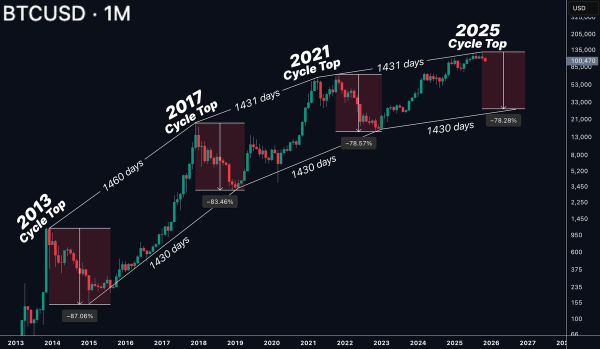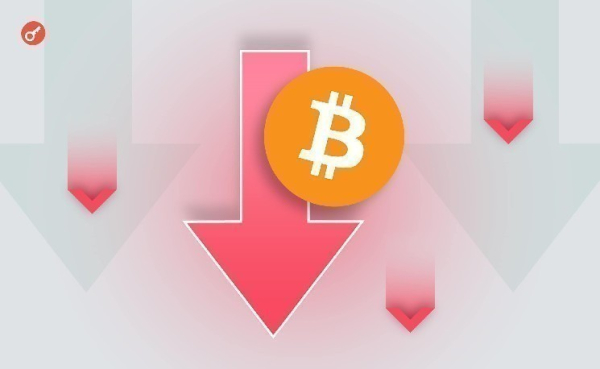Will Bitcoin's Four-Year Cycle Continue?

The debate over the viability of Bitcoin's four-year cycle has divided cryptocurrency analysts, and neither side is ready to give up yet.
We're mid-November, traditionally considered the strongest month of the year for Bitcoin. But the reality is stark: the cryptocurrency's price is lower today than it was on January 1st. At the time of writing, Bitcoin is trading at $91,211, down 15% in ten days. This isn't exactly rosy news for Tom Lee and Arthur Hayes, who predicted a $250,000 price target by the end of the year.
When ETFs Change the Rules of the Game
If Bitcoin's four-year cycle is truly valid, then the October high of $125,100 should technically be the cycle's peak. This is approximately 18 months after the halving in April 2024—precisely according to the traditional pattern: 18 months of a bull market after the halving, followed by a sharp correction and a prolonged decline until the next halving.
Michaël van de Poppe, founder of MN Trading Capital, believes Bitcoin will reach a new all-time high in 2026: “Over the past 18 months, 60,000 Bitcoin have been purchased through Bitcoin ETFs—that's significant, ongoing institutional demand.” However, he cautions that declaring the cycle dead is “short-sighted.”
 Bitcoin ETF Market Cap. Source: Coinglass
Bitcoin ETF Market Cap. Source: Coinglass
Van de Poppe admits, “This cycle is indeed behaving differently,” but emphasizes that the October high could still prove to be the cycle's peak. “We are at a crossroads of market changes, the maturation of an asset like Bitcoin, and, consequently, different market dynamics.”
Bitwise Chief Investment Officer Matt Hougan is convinced that the cryptocurrency market's flatline at the end of 2025 increases the potential for a rebound in 2026. “The market fundamentals are truly strong,” Hougan stated. “Institutional investment, regulatory progress, stablecoins, tokenization—all these forces are too powerful to contain. Therefore, 2026 will be a successful year.”
Macroeconomics versus optimism
BitMEX founder Arthur Hayes dismisses the idea that Bitcoin follows a traditional cycle. He noticeably downplayed his $250,000 by year-end prediction in his latest Substack post, arguing that Bitcoin will only rise to new heights when markets weaken enough to force central banks to return to aggressive monetary stimulus.
Swyftx lead analyst Pav Hundal is also closely monitoring macroeconomic data, saying it's too early to declare a top for this cycle. “Any decline in inflation or concerns about labor indicators will simply put us back on the path to lower rates.”
Jerome Powell's recent statements have created uncertainty in the market, and the likelihood of a December rate cut has now dropped to 40%, according to the CME FedWatch tool. Hundal says the market is currently “floating blindly” while awaiting clearer data. “The problem isn't just with Bitcoin. The red light is on for all risk assets.”
Defenders of the traditional cycle
But there are analysts and executives who have been insisting for months that the four-year cycle is still in place. And the current collapse confirms their correctness.
Renowned cryptocurrency analyst Rekt Capital warned back in July that the current rally left “very little time and room for price movement upward.” He recently added that it will take a long time to determine whether Bitcoin's cycle has lengthened or has finally ended.
 BTC/USD 1-Month Chart. Analysis by Linton Worm
BTC/USD 1-Month Chart. Analysis by Linton Worm
Gemini's head of Asia-Pacific, Saad Ahmed, believes four-year cycles are here to stay. “We'll likely continue to see cycles in one form or another. People get excited, overestimate their strength, then there's a crash, and the price returns to equilibrium.”
Analyst Colin Talks Crypto declared: Bitcoin's price festivities are over. “If a quick recovery doesn't occur in the next day or two, we're entering a bear market or a significant correction.”
Bitcoin's four-year cycle has become the subject of heated debate just when the market needs certainty most. Institutional ETFs have indeed changed everything, but it remains to be seen whether they will end the familiar patterns.
Source: cryptonews.net



